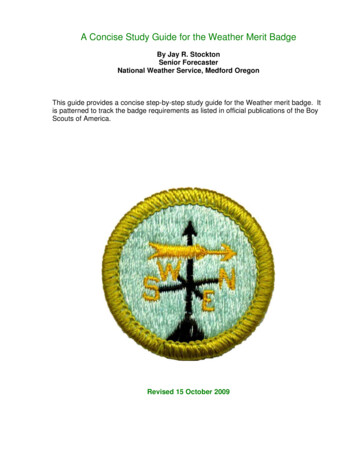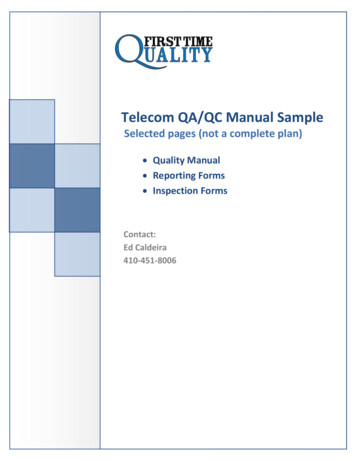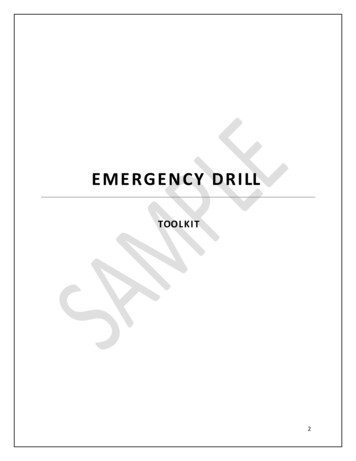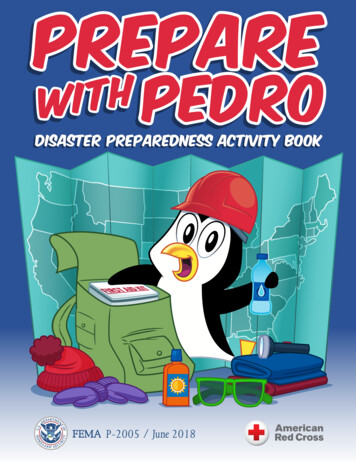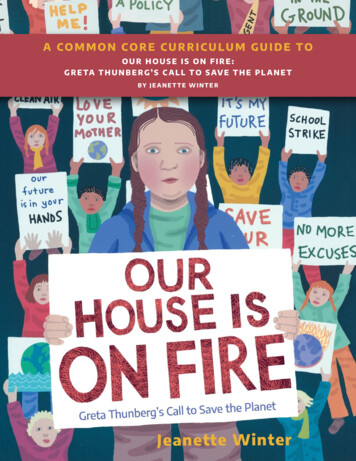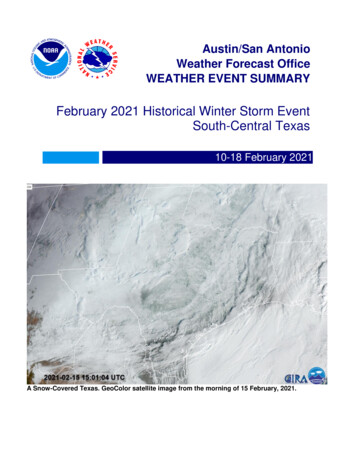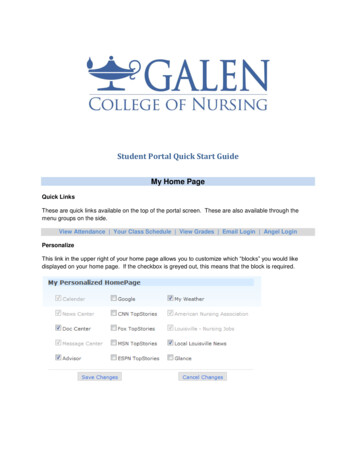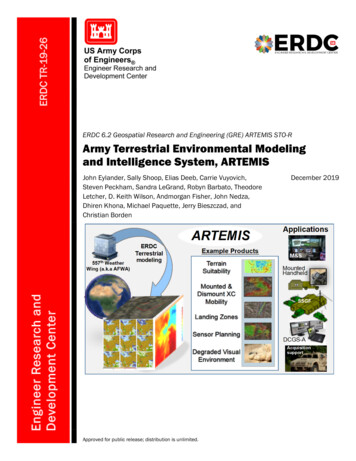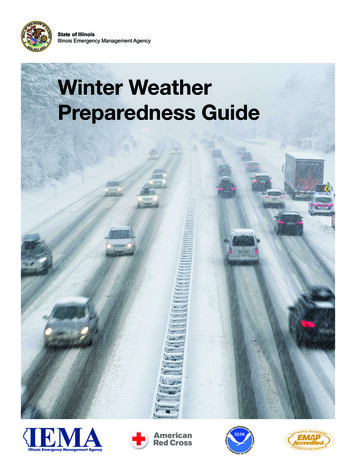
Transcription
State of IllinoisIllinois Emergency Management AgencyWinter WeatherPreparedness Guide1
Prepare Today for Winter WeatherWinter weather in Illinois may be inevitable, but being prepared will help you handle whatever weather hazards Mother Naturethrows our way this year. Knowing what to do before a disaster strikes can provide peace of mind and ultimately impact our recoveryprocess.To help Illinois residents be prepared for winter weather this year, the Illinois Emergency Management Agency (IEMA) and theNational Weather Service (NWS) developed this Winter Weather Preparedness Guide to help you and your family prepare for and staysafe during winter weather.Preparing for winter also means adjusting your driving habits. Snowy or ice-coated roads and reduced visibility due to fog orblowing snow results in thousands of motor vehicle crashes every year in Illinois. Many of these crashes can be avoided by slowingdown on city streets, rural roads and highways. Recent traffic studies have shown that many times, minor accumulations of snowor ice on roads can be just as dangerous for motorists as major snowstorms. This Winter Weather Preparedness Guide includesinformation about winter travel safety guidelines, winter weather terminology and tips to prepare your vehicle and home for winterstorms.Proper home heating is also a critical issue during the winter months, and over time has proven deadly for many families. Everyyear, more than 400 people die in the U.S. from accidental carbon monoxide (CO) poisoning. According to the Centers for DiseaseControl (CDC), approximately 20,000 people in the U.S. visit the emergency department each year due to accidental CO poisoning.CO is found in fumes produced any time you burn fuel in cars or trucks, small engines, stoves, lanterns, grills, fireplaces, gas ranges,or furnaces. CO can build up indoors and poison people and animals who breathe it. Use this winter weather preparedness guide toeducate your family about the dangers associated with this home heating hazard.Keep in mind, being prepared for winter doesn’t have to cost a lot of money or take a lot of time. It could be as simple as makingsure your vehicle is in good winter driving condition, adding a winter survival kit to your car, changing your furnace filter at home andstocking or updating your family’s emergency supply kit.Take time now to prepare your family, home, vehicles and driving habits for everything from a dusting of snow to a major winterstorm.2
Illinois WinterWeather FactsCOLD TEMPERATURES A study published in 2020 by the University of Illinois Chicagofound that nearly 95% of temperature related deaths inIllinois were due to cold weather. The coldest temperature on record occurred on January 31,2019, when the mercury dipped to minus 38 degrees nearMt. Carroll in Carroll County.WINTER STORMS On average, Illinois experiences five severe winter stormseach year. From November 2020 through April 2021 therewere eight (8) snow or ice storms that impacted Illinois. Therehas not been a winter in Illinois without at least one winterstorm in the past century. Winter driving conditions contribute to an average of nearly29,000 vehicle crashes, more than 4,500 injuries and 80fatalities in Illinois each year.SNOWFALL Average annual snowfall ranges from 37 inches of snow inRockford and Chicago, to as little as 6 to 10 inches at thesouthern tip of Illinois. The greatest snowfall on record from a single storm was27.9 inches measured near Waukegan in Lake County, fromJanuary 3-5, 2015.ICE STORMS On average, locations from just south of Quincy, throughLincoln, to Watseka experience more freezing rain and icestorms than any other part of the state.3
Winter Weather TermsWINTER WEATHER TERMSThe National Weather Service uses the terms below to conveythe weather threat to the public. Freezing Rain: Precipitation that falls from the clouds asrain, but freezes into a glaze of ice on groundbased objects(trees, power lines, roads, cars, etc.). Sleet: Small pellets of ice created by frozen raindrops.Sleet bounces when hitting a surface and does not stick toobjects. Wind Chill: A calculation of how cold it feels outside whenthe effects of temperature and wind speed are combined.Wind chill ONLY applies to bare, human skin. The effectsof wind chill are different for animals and don’t apply tonon-living objects.WATCHES, WARNINGS & ADVISORIES Winter Storm Watch: Issued for potentially significantwinter weather, including heavy snow ice, sleet, and/orblowing snow within the next day or two. Now is the timeto prepare! Winter Storm Warning: Indicates heavy snow, blowingsnow, sleet or a combination of winter weather hazardsare expected to cause a significant impact to life orproperty. Stay indoors and adjust travel plans. Snow Squall Warning: Sudden whiteout conditions withnear zero visibility and flash freezing of road surfacesresulting in potentially life threatening conditions fortravelers due to bursts of heavy snow in a localized area.Before a Winter Stormor Extreme Cold Blizzard Warning: Strong winds (35 mph or greater) willproduce blinding snow and near zero visibility, resulting inpotentially life-threatening conditions – particularly fortravelers. Blizzards can occur with minimal accumulationsof snow.WEATHER TERMS: Know the terms related to winter stormsand extreme cold. COUNTY NAMES: Know the names of the counties in whichyou live, work and travel. County names are used to identifyareas at risk.Ice Storm Warning: Heavy accumulations of ice areexpected to cause a significant impact to life orproperty, resulting in hazardous travel conditions, treedamage and extended power outages.HEALTH PRECAUTIONS: Learn how to protect your family’shealth during the winter months. Dress appropriately for the winter. Learn the physical dangers to your body.Winter Weather Advisory: Snow, blowing snow, ice and/orsleet is expected to produce potentially dangerous travelconditions within the next 12 to 36 hours. Wind Chill Warning: Life-threatening wind chills of minus25 degrees or colder. Wind Chill Advisory: Dangerous wind chills of minus 15degrees to minus 24 degrees.DISASTER KITS: Gather emergency supplies for work andhome.Create a Family Emergency Supply Kit. See box below forimportant items for your kit.FAMILY EMERGENCY SUPPLY KITA few important kit items are listed below: A battery-powered National Oceanic and Atmospheric Administration (NOAA) Weather Radio and a battery poweredcommercial radio and extra batteries.Foods that do not require cooking or refrigeration are best. Include high energy foods such as dried fruit andgranola bars.Extra medications and special items for babies, the disabled or elderly.Extra water in clean containers.Flashlights and extra batteries. Do not use candles.A first-aid kit, non-prescription drugs and personal sanitary items.Pet supplies.Face mask, hand sanitizer, sanitizing wipesFor details, go to: yKit.aspx.4
WINTERIZE YOUR HOME: Winterize your home to extendyour fuel supply. Insulate walls and attics. Caulk and weatherize doors and windows. I nstall storm windows or cover windows with plastic.a severe winter storm, regular fuel carriers may notreach you for days. Have emergency heating equipment (fireplaces, woodburning stoves or space heaters) and ample fuel soyou can keep at least one room of your house warm.Always ensure proper ventilation to avoid carbonmonoxide poisoning.FROZEN PIPES: Take steps to prevent frozen water pipes. Locate and insulate the pipes most susceptible to freezing:typically those near outer walls, in crawl spaces or in attics. NEVER use an outdoor grill to heat your home or tocook food indoors. Heat tape or thermostatically controlled heat cables can beused to wrap pipes. Be sure to use products approved byan independent testing organization, such as UnderwritersLaboratories Inc., and only for the use intended (exterior orinterior). Closely follow all manufacturers’ installation andoperation instructions. Keep fire extinguishers on hand and make sure yourfamily knows how to use them. Seal any leaks that allow cold air inside where pipes arelocated. Disconnect garden hoses and shut off and drain water frompipes leading to outside faucets. Make sure you know how to shut off the water, in casepipes burst.PREPARE YOUR VEHICLE FOR THE WINTER:PREPARE FOR POSSIBLE ISOLATION IN YOUR HOMEFOR SEVERAL DAYS: Make sure you have sufficient heating fuel. After Winterize your vehicle or have your vehicle serviced bya reputable dealer, garage or mechanic. Check your wipers, tires, lights and fluid levelsregularly. Make sure the brakes and transmission areworking properly. Lubricate door and trunk locks toprevent them from freezing. Prepare a Winter Storm Survival Kit and carry it inyour vehicle. A kit is important even for short trips. Ifyou have an accident or vehicle breakdown, you maybe waiting several hours for assistance to arrive. Seebelow for “Winter Storm Survival Kit for Travelers.”Winter Storm Survival Kit for TravelersCell phone and chargerA smaller can and water-proof matches tomelt snow for drinking waterBlankets/sleeping bagsSack of sand (or cat litter)Flashlight with extra batteriesShovelFirst-aid kitWindshield scraper and brushKnifeTool kitHigh calorie, non-perishable foodTow rope with loops (avoid chains andhooks if at all possible)WaterBooster cablesExtra clothing to keep dryWater containerA large empty can and plastic coverwith tissues and paper towels forsanitary purposesCompass and road mapsFace mask, hand sanitizer5
Illinois Winter During Winter Storms and Extreme ColdWHEN AT HOME Stay indoors in a heated room as much as possible. Hang blankets over windows at night, but let the sun shine in during the day. Cover cracks around doors with rugs, newspapers,towels or other such material. When using alternative heat from a fireplace, wood stove, space heater, etc., use safeguards and ensure proper ventilation toavoid carbon monoxide poisoning. Refuel kerosene heaters outside and keep them at least three feet away from flammable objects. If you have no heat, close off unneeded rooms and place towels or rags under the doors. If your water pipes freeze: Shut off water at the main source. This can minimize the damage to your home.Call a plumber and contact your insurance agent.Never try to thaw a frozen pipe with an open flame or torch.Always be aware of the potential for electric shock in and around standing water.HOME HEATING HAZARDS Carbon Monoxide is a odorless, colorless gas that can kill you. Symptoms include headache, dizziness, weakness, upset stomach, vomiting, chest pain and confusion Do not use portable flameless chemical heaters indoors. Make sure your gas appliances are vented properly. Have your chimney checked or cleaned each year. Never use a gas range or oven for heating. Never burn charcoal indoors Never use a portable gas camp stove indoors Never use a generator inside your home, basement, garage or less than 20 feet from any window, door or vent. Install a battery-operated or battery back-up CO detector in your home and check/replace batteries when you change the timeon your clocks each spring and fall.WHEN OUTSIDEAvoid overexertion, such as shoveling heavy snow, pushing a car or walking in deep snow. Thestrain from the cold and the hard labor of snow shoveling could cause a heart attack at any age– a major cause of death in the winter. Don’t ignore chest pain or tightness in your chest. If you become stranded outdoors, seek shelter to stay dry. Cover all exposed parts of thebody. If no shelter is nearby, prepare a lean-to, windbreak or snow cave for protection fromthe wind. Build a fire for heat and to attract attention. Do not eat snow as it will lower yourbody temperature. Melt it first. Watch for signs of frostbite and hypothermia. Frostbite is a severe reaction to cold exposure of the skin that can permanently damagefingers, toes, the nose and ear lobes. Symptoms are numbness and a white or paleappearance to the skin. When symptoms are apparent, seek medical help immediately. Ifmedical help is not immediately available, slowly warm the affected areas.6
Hypothermia, or low body temperature, is a life-threatening condition brought on when the body temperature falls below 95degrees.Symptoms of hypothermia include slow or slurred speech, incoherence, memory loss, disorientation, uncontrollable shivering,drowsiness, repeated stumbling and apparent exhaustion.If these symptoms are detected, take the person’s temperature. If below 95 degrees, immediately seek medical attention. Ifmedical help is not available, begin warming the person slowly. Always warm the body core first. Do NOT warm the arms andlegs first – this can force the cold blood toward the heart and can lead to heart failure.Get the person into dry clothing, and wrap them in a warm blanket covering the head and neck. Do not give the victim alcohol,drugs, coffee or any hot beverage. Warm broth is better.RECOMMENDED WINTER ATTIRE Wear loose fitting, lightweight, warm clothing in several layers. The trapped air between the layers insulates. Layers can beremoved to avoid perspiration and subsequent chill. Wear outer garments that are tightly woven, water repellent and hooded. Wear a hat. A significant amount of body heat is lost through the top of the head. Wear mittens that are snug at the wrist. Mittens offer better protection. Gloves allow your fingers to cool much faster thanmittens. Cover the mouth and nose with scarves to help protect lungs from cold air. Keep your feet as dry as possible. Wear wool socks.ON THE FARM Move animals to sheltered areas. Haul extra feed to nearby feeding areas. Have a water supply available. Most animal deaths in winter stormsoccur from dehydration.WHEN TRAVELINGIf you decide a trip cannot be delayed, consider using public transportationif it is available. If you decide to drive your vehicle, take the followingprecautions:Before You Leave Check the latest weather conditions along your planned travel route. Listen to weather forecasts on TV, local radio stations oron a NOAA Weather Radio. Visit the IDOT website (www.gettingaroundillinois.com) to get current road conditions for Illinois’interstate systems. Check your wipers, tires, lights and fluid levels. Lubricate door and trunk locks with lock lubricant to prevent freezing. Start witha full tank of gas. Travel during daylight hours on main roads and don’t travel alone. Carry a Winter Storm Survival Kit in your vehicle. (see page 5) Provide your itinerary to a friend, relative or co-worker. Include information on your destination, the routes you will travel andwhen you expect to arrive. When you reach your destination, make a call to report that you have arrived.7
On the Road Buckle your seat belts! Be prepared to turn back and seek shelter if conditions become threatening. Keep your windows clear of snow and ice. Do not start driving until your windshield is defrosted. Drive slower and increase your following distance. Your speed should be adjusted for the conditions and match the flow oftraffic. Only use a cell phone if you are safely over to the side of the road or in a parking lot. Never talk on a cell phone while driving.This is especially dangerous in winter weather conditions. Roadway conditions may vary depending on the sun, shade or roadway surface. Watch for slick spots especially under bridges,on overpasses and in shaded areas. If the pavement is snow or ice covered, start slowly and brake gently. Begin braking early when you come to an intersection. If you start to slide, ease off the gas pedal or brakes. Steer into the direction of the skid until you feel you have regained traction,and then straighten your vehicle. If your vehicle becomes stuck in the snow, contact a towing company, but be prepared to wait in the cold weather for up toseveral hours. If you can be safely pulled out by another vehicle, make sure you use tow ropes with loops on the ends. Avoidchains or hooks if at all possible, since these can slip off and recoil very quickly, causing injury or death. When a snowplow is coming toward you, allow plenty of room for the truck to pass. When the center line is being cleared andsalted, the plow tip may be on or over the line. When you approach a snowplow from behind, pass with care and only when you can see the road ahead of the truck. You shouldnot try to pass in blowing snow; there may be a vehicle in that cloud of snow. Allow more distance than usual between you andthe plow. Refuel often, keeping your gas tank near full to prevent ice in the tank and fuel lines, which could leave you stranded.These frequent stops should also help relieve tense muscles.If Stranded Pull as far off the road as possible, set your hazard lights to“flashing,” and hang or tie a colored cloth (preferably red) toyour antenna, window or door. After the snow stops falling,raise the hood to indicate trouble. If you have a cell phone,call for help. Stay in your vehicle, where rescuers are most likely to findyou. Do not set out on foot unless you can see a buildingclose by where you know you can take shelter. Make sure the exhaust pipe is not blocked by snow, andthen run the engine and heater about 10 minutes each hourto keep warm. Turn on the dome light at night when runningthe engine. When the engine is running, open a windowslightly for ventilation. Periodically clear away snow from the exhaust pipe. Exercise to keep blood circulating and to maintain body heat by vigorously moving arms, legs, fingers and toes. In extreme cold,or if you don’t have a Winter Storm Survival Kit, use road maps, seat covers and floor mats for insulation. Take turns sleeping. One person should be awake at all times to watch for rescue crews. Be careful not to deplete battery power. Balance electrical energy needs such as lights, heat and radio, with electrical energysupply.8
Safety for SchoolsChildren can be especially susceptible to the dangersassociated with winter weather. Even if they are cold,wet or exhausted, they often are not conscious of thepotential threats these conditions could pose. Schooladministrators, principals and teachers need to be awareof the risks of winter weather. Emergency plans andprocedures must be established or reviewed before theonset of the winter season to ensure children’s safety.WINTER SAFETY PROCEDURES FOR SCHOOLSProcedures for schools should include: A means of receiving current weather information. The National Weather Service (NWS) provides this information viaNOAA Weather Radio and websites (see listing on page 10). Commercial radio and television also air winter weatherconditions. Guidelines for children’s outdoor activities. Plans for closures, early dismissal or holding children and staff at school due to snow, ice or extreme cold. Provisions for children who arrive earlier than usual or stay later than usual due to driving conditions parents mayencounter.Transportation–Related Considerations: Bus driver training for winter conditions. Changes in routes (alternate) during winter conditions. Procedures for altered school schedules. Procedures to deal with stranded buses.Wind ChillMost of the time, cold is judged in terms of a thermometer reading. With people and other living things though, both temperatureand wind speed are needed to produce a “wind chill factor.” The wind chill is based on the rate of heat loss from exposed skincaused by the combined effects of the wind speed and cold temperatures. As the wind increases, heat is carried away from thebody at an accelerated rate, driving down the body temperature. The wind chill shows how cold the wind makes exposed fleshfeel and is a good way to determine the potential for frostbite or hypothermia.Remember, wind chill only applies to people. The effects of wind chill are different for animals. If the temperature is 35 degreesand the wind chill is 10 degrees, objects such as pipes or cars will only cool to 35. The wind chill factor does not apply to nonlivingobjects.9
NATIONAL WEATHER SERVICE WIND CHILL CHARTRead right, and down from the calm-air line. For example, a temperature of zero combined with a 20 mph windhas an equivalent cooling effect of minus 22 degrees.Additional Sources of InformationFor additional information on winter storms or other hazards, contact the following:Your local emergency management agency (EMA or ESDA)Ready Illinois web page: http://ready.illinois.govThe website of the nearest National Weather Service (NWS) office:Davenport, IA www.weather.gov/DavenportRomeoville, IL www.weather.gov/ChicagoLincoln, IL www.weather.gov/LincolnSt. Louis, MO www.weather.gov/StLouisPaducah, KY www.weather.gov/PaducahYour local chapter of the American Red Cross (ARC) or www.redcross.orgIllinois Dept. of Transportation – Road Conditions: www.gettingaroundillinois.comPrinted by the Authority of the State of IllinoisIOCI 22-0450 0 Copies (11/21)10
Winter weather in Illinois may be inevitable, but being prepared will help you handle whatever weather hazards Mother Nature throws our way this year. Knowing what to do before a disaster strikes can provide peace of mind and ultimately impact our recovery . Disconnect garden hos
